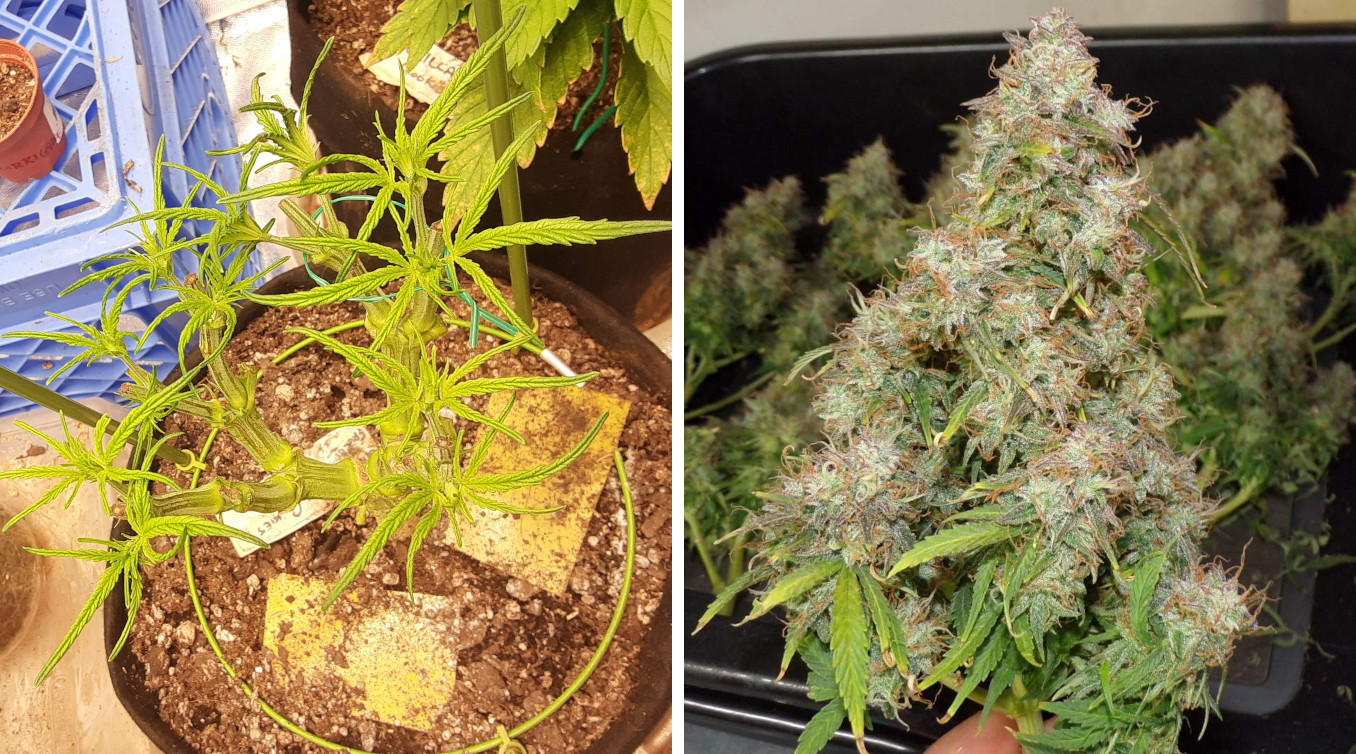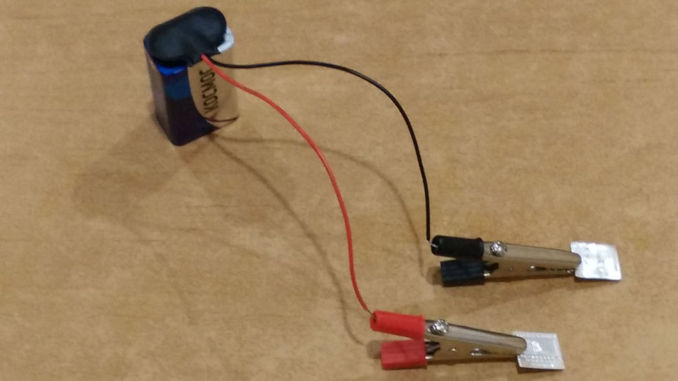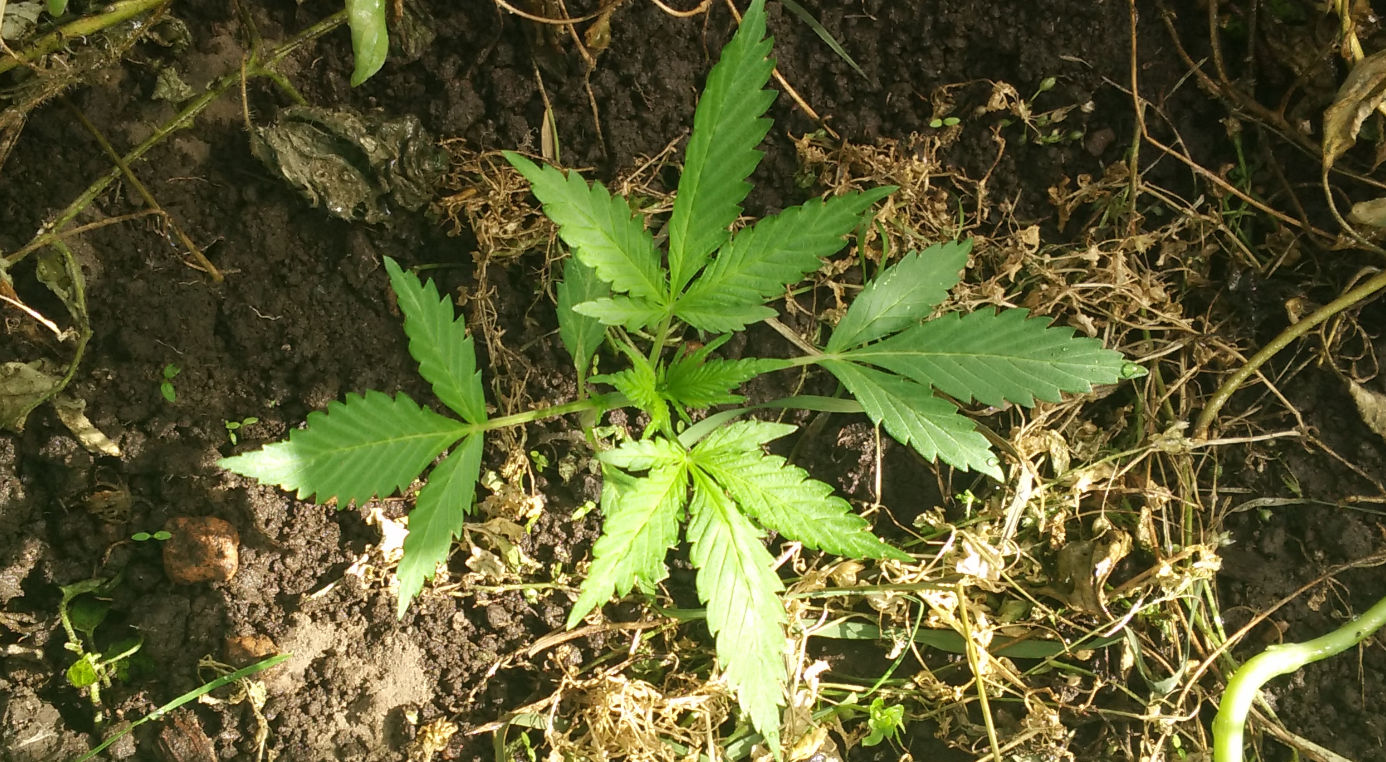Not long ago, people used to think of autoflowers as something fragile, finicky, tiny, and potentially low-yielding. The common stance was that anything could shock and stunt them. Hence, the autoflower defoliation was a big no-no, the same as transplanting and various high- and low-stress techniques. Luckily, that has changed.
Autoflower defoliation has become a standard canopy-management method, and we’ll show you how and when to perform it. Armed with these guidelines, you’ll learn to use autoflowers trimming as the means to achieve bigger plants and over-the-top production.
The Most Important Question — Why?
Autoflower defoliation shouldn’t be thought of as some devilishly clever way to cheat Nature. We don’t need to cheat. We just see a problem and help plants deal with it. If there’s no problem, we leave them alone.
So let’s look at the situations where you can benefit your autoflowers by trimming and defoliating them:
- Better canopy ventilation. If you’re afraid there’s a lack of air movement in the bottom part of the bush or inside it, remove the excess foliage. Or else you can run into problems with mold.
- Increasing light exposure. Probably the main reason for autoflower defoliation indoors. Make sure that fan leaves don’t shade any bud sites. And if they do, remove them.
- Getting rid of old leaves. When a plant has sucked all the juices out of lower fan leaves, there is no reason whatsoever to leave them on branches. If the lower leaves are still green, don’t shade anything, nor block air movement, it’s okay to leave them.
- Slowing down a particular branch. Sometimes one of the top shoots is growing too fast and is overtaking all the rest. One of the ways to curb its growth and allow the rest of the branches to catch up is to defoliate it.
- Reducing overall perspiration during drought. I used to do this in my guerilla growing days. I prefer to let my outdoor plants grow naturally, but during a heat wave I defoliate more generously. The less foliage, the less precious water the plant loses.
Drawbacks of Autoflower Defoliation
There are definitely quite a few cons to autoflower defoliation. Let’s look at them too.
- Each leaf contributes to photosynthesis. Chemical reactions inside leaves produce building materials and energy to be used elsewhere in the plant. So defoliate only if you think that the benefits of defoliation outweigh the leaf’s contribution to photosynthesis.
- Each leaf is a depo of essential elements. So-called mobile nutrients (N, P, K, Mg, and Mo) can be transported from older leaves to new growth as needed. So if you notice a deficiency of any of these nutrients, you’ll only make things worse by defoliation.
- Slowed down growth due to stress. Autoflower defoliation, pruning, topping—they all produce a spike in jasmonic acid. It’s a kind of a stress hormone which makes plants temporarily suspend growth and direct the saved energy to wound healing. On the other hand, the right amount of stress can produce just enough jasmonic acid to actually make weed more potent, as one study suggests.
- Risk of hermaphroditism due to stress. It’s not the worst kind of stress (not as bad as chaotic light cycle, for example), but in weaker genetics it can be enough to make female plants produce male flowers (hermies).
These drawbacks don’t give enough reason to forget about autoflower defoliation altogether, but you should always make sure the good outweighs the bad. And sometimes you might prefer a little less invasive and stressful procedure like leaf tucking.
Leaf Tucking: The Alternative to Autoflower Defoliation

Red circles show where leaves were tucked and tied together instead of defoliation. © Growdiaries
If larger fan leaves are in the way but you think it’s best to leave them on the plant for now, you can tuck them under a branch. Let’s have a look at one way this can be done.
A skillful grower who calls himself Bloombuster obviously hates autoflowering defoliation and uses the ‘x-leaves’ technique instead. He takes two opposing fan leaves, tucks them under a branch and ties them together by their petioles.
At harvest, the plant is a monster. Maybe too leafy to some people’s taste, but a very generous producer.

Gorilla Cookies Auto (FastBuds)
The yield of this monster from FastBuds is 220 g (7.76 oz) from 1 plant. This indoor garden is actually just one autoflower, grown without heavy defoliation. © Growdiaries
Heavy Autoflower Defoliation as a Yield Boosting Technique
So far, we’ve only been talking about selective defoliation of autoflowers. You cast a critical eye on your plant and remove only those parts that don’t fit your vision.
However, many growers see defoliation (especially heavy defoliation) as a kind of a magic bullet As if it somehow could automatically transform your plant into a super producer. This view was given a boost by the rise of schwazzing, a form of extreme defoliation.
Schwazzing was popularized by the book Three a Light. The name obviously means ‘three pounds of dry bud per a 1000W light’. The book describes at what stages in a plant ‘s cycle heavy defoliation should be performed and how many days of rest to give your plants between sessions and what nutrients to feed them. People love clear and easy-to-follow guidelines like this.
Btw, schwazzing was developed for photoperiod genetics, not autoflowers.
Nevertheless, some growers experiment with extreme forms of autoflower defoliation too. Obviously, they hope to come up with some step-by-step instructions that will guarantee bigger yields every time. We’d say it’s wishful thinking because every strain is different. Moreover, every batch of seeds in a strain and every seed in a batch are different. So it’s a flip of a coin how your particular autoflower will react to heavy defoliation
Having said that, we’ve compiled a short list of guidelines that most autoflower defoliation enthusiasts agree on:
- don’t remove more than ⅓ of fan leaves at a time,
- remove only those leaves that have stopped growing,
- allow for at least a week between sessions,
- you can defoliate in veg but not just before the transition to flowering,
- it’s okay to defoliate during flowering (weeks 2-3) but only before the stretch is over,
- never trim leaves in late flower (after approx. week 8 from seed).
A Sample Autoflower Defoliation Schedule for the Whole Life Cycle
| Defoliation: | Selective | Heavy | Pre-Harvest | |
| Weeks | 1 | – | – | – |
| 2 | – | – | – | |
| 3 | ✓ | – | – | |
| 4 | ✓ | ✓ | – | |
| 5 | ✓ | – | – | |
| 6 | ✓ | ✓ | – | |
| 7 | ✓ | ✓ | – | |
| 8 | ✓ | ✓ | – | |
| 9 | – | – | – | |
| 10 | – | – | ✓ | |
As you can see in the table above, a special case is defoliating an autoflower before harvest. If you do this right before chopping your plant or right before subjecting her to a dark period before harvest, it’s not really defoliation. It’s rather a form of wet trimming. You’re going to remove all fan leaves anyway, and often it’s more convenient to do this while the plant is still standing in her container.

LSD Auto (Barney’s Farm)
And even if you give her a day or two to mature under the light after this heavy trimming, it’s really okay. The stress might actually make buds even more potent. Grower ClubRiot removes all fan leaves and trim before harvest because it’s a convenient way to manicure buds. © Growdiaries
And even if you give her a day or two to mature under the light after this heavy trimming, it’s really okay. The stress might actually make buds even more potent.
A Few Examples of Heavy Autoflower Defoliation
Suboptimal Results
In our first example, a grower who calls himself chubbs decided to subject his autoflower to heavy defoliation in week 7. For many reasons, this auto hadn’t been growing vigorously from the start, and the heavy defoliation hardly helped. Besides, the guy chose to defoliate his autoflower before harvest a little too early — at least one full week before the chop. The yield wasn’t spectacular, but the quality of the buds was top-notch. Probably, thanks to the strong genetics.

Forbidden Runtz Auto (FastBuds)
The yield of this monster from FastBuds is 17 g (0.6 oz) from 1 plant. Heavy defoliation in week 7 and another radical one a week or two before harvest. © Growdiaries
Example 2. In addition to topping and mainlining a Girl Scout Cookies Auto by Fastbuds, the grower calling himself HobbitGDF defoliated her heavily in week 5. All these high-stress training techniques probably delayed the start of flowering—till week 7. As a result, the buds were only ready after a full 13 weeks from seed.

Girl Scout Cookies Auto (FastBuds)
71g (2.5oz) from 1 plant. The harvest pic looks nice, but it’s debatable whether heavy defoliation has helped with the yield. © Growdiaries
Lucky Outcomes
In our third example, the grower (Canamatoes) did multiple toppings and mainlining and performed a thorough defoliation on several occasions. The one in the picture is in week 6 (the second week of flowering). The Kosher Cake Auto by FastBuds responded great and yielded 261g (9.21oz) of top-shelf bud.

Kosher Cake Auto (FastBuds)
261g (9.21oz) from 1 plant. It’s not every genetics that can take so much abuse and still come out on top. © Growdiaries
And finally, the grower (Cali_Grown_420) used less stressful methods, such as FIMming, and defoliated more lightly and only once—in week 5 (the first week of flowering). In the picture, you can see one of three plants. All three have yielded 308g (10.9oz).

Cream Cookies Auto (FastBuds)
308g (10.9oz) from 3 plants. This gardener has chosen selective defoliation, and the result is spectacular. © Growdiaries
Don’t Get Carried Away!
Combing through Growdiaries, we have seen quite a few successful autoflower grows involving heavy defoliation. At the same time, many results were less than spectacular. Sometimes, it seemed that a simpler approach would lead to a more generous yield.
Often, when a grow journal shows a MONSTER bush at harvest, it’s impossible to find a picture where you can tell that the plant has just been defoliated. Because the grower defoliated only moderately, a few leaves here and there, nothing radical.
This smart approach to autoflower defoliation seems to work best. But maybe you have a different opinion. Tell us what you think in the comments.
The Best Cannabis Srore

Price: from $5

Pack: from 1 seed

Shipping worldwide

Price: from $15

Pack: from 1 seed

Fast ship US only - 1 day

Price: from $80

Pack: from 5 seeds

Shipping US only

Price: from $50

Pack: from 5 seeds

Shipping worldwide













Comments